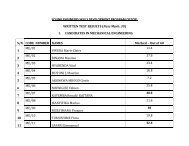lois et reglements police de roulage avec amendements
lois et reglements police de roulage avec amendements
lois et reglements police de roulage avec amendements
You also want an ePaper? Increase the reach of your titles
YUMPU automatically turns print PDFs into web optimized ePapers that Google loves.
Article 71:<br />
1. When the distance b<strong>et</strong>ween the front of a traller and the back of the towing vehicle exceeds 3<br />
m<strong>et</strong>res, their fastening must be signalised:<br />
- by daytime, by a red piece of cloth measuring a minimum 0.50 m<strong>et</strong>re by si<strong>de</strong>;<br />
- when the lighting of the vehicle is required : by an orange coloured light laterally visible,<br />
unless fastening is enlightened.<br />
2. A fastening can only be used in cases of circumstances outsi<strong>de</strong> one's control and exclusively<br />
for pulling a vehicle all the way to the place of repair at a speed which in, any case can not<br />
exceed 20 km per hour.<br />
These fastenings must be shown by a square white panel of at least 0.30 m<strong>et</strong>re by si<strong>de</strong>, placed at<br />
the head end of the towing vehicle.<br />
3. Paragraph 2 of this article notwithstanding, when the authorised maximum weight of a traller<br />
exceeds 750 Kg or half unla<strong>de</strong>n weight of the towing vehicle and that its brake system does not<br />
automatically provoke the stoppage in the case of the breakage of the main fastening the said<br />
traller must be in addition to the main fastening ensuring the traction and the driving of the<br />
traller, equipped with an emergency fastening which can be constituted by chains or m<strong>et</strong>allic<br />
cables so as, in the case of <strong>de</strong>ficiency of the main system, to pull the traller and to keep it from<br />
leaving its route and keep the shaft from touching the ground.<br />
This emergency fastening can be used after the breakage of the main system only in the cases<br />
provi<strong>de</strong>d for in. paragraph 2 of this article.<br />
Chapter 5. EXCEPTIONAL TRANSPORTS<br />
Article 72:<br />
1. Transportation of indivisible objects and putting in circulation vehicles or traller used to carry<br />
these objects, and of which d<strong>et</strong>alls exceed the maximal limits fixed by this Decree, are<br />
authorised by the Minister having Transports in his duties at the conditions fixed by him.<br />
2. When the authorisation required concerns width, height or weight, it must mention the date<br />
and if necessary the tim<strong>et</strong>able and the route according to which the transports will be effected.<br />
3. This authorisation prescribes provisions which must be taken in or<strong>de</strong>r to ensure the easiness<br />
and the security of the traffic and to prevent any damage to the public highway, its surrounding<br />
parts, to works of civil engineering which have been built there and to bor<strong>de</strong>ring properties.<br />
4. This authorisation is granted to the applicant only when he accepts to pay the damages and<br />
fees relating to the transport and to <strong>de</strong>posit, where necessary, a guarantee of which the amount<br />
is fixed in the authorisation.<br />
5. This authorisation can be granted to the applicant only for one trip, except in the case of<br />
transporting things presenting a real general interest.<br />
6. Transporting by road vehicles of empty or loa<strong>de</strong>d rallway wagons may require valid<br />
authorisation either for a single trip or for several.<br />
Provisions of paragraphs 1 and 4 are applicable for these transports.<br />
Article 73:<br />
In cases violating provisions of Article 67 or conditions of the authorisation issued in<br />
conformity to Article 72, the driver is obliged to offroad, to unyoke or to stop his vehicle in the




